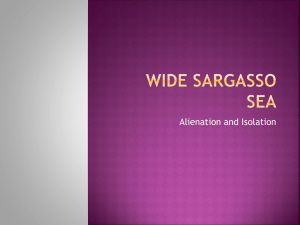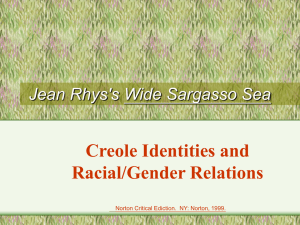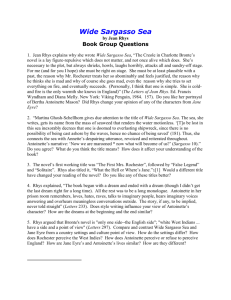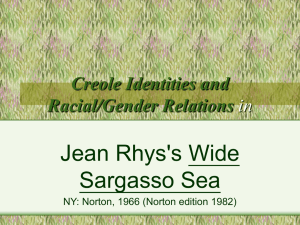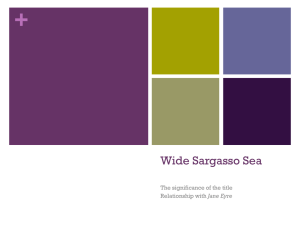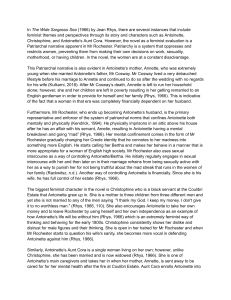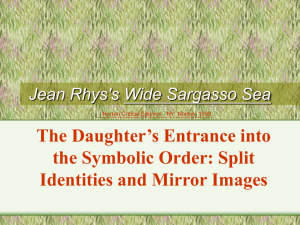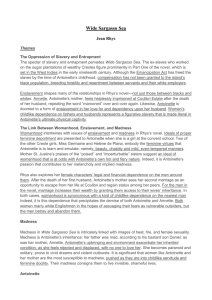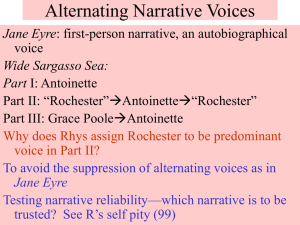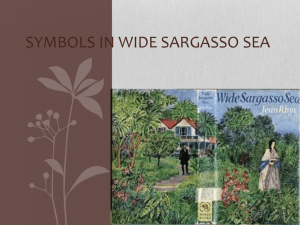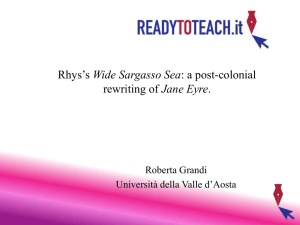Historical Background of Wide Sargasso Sea
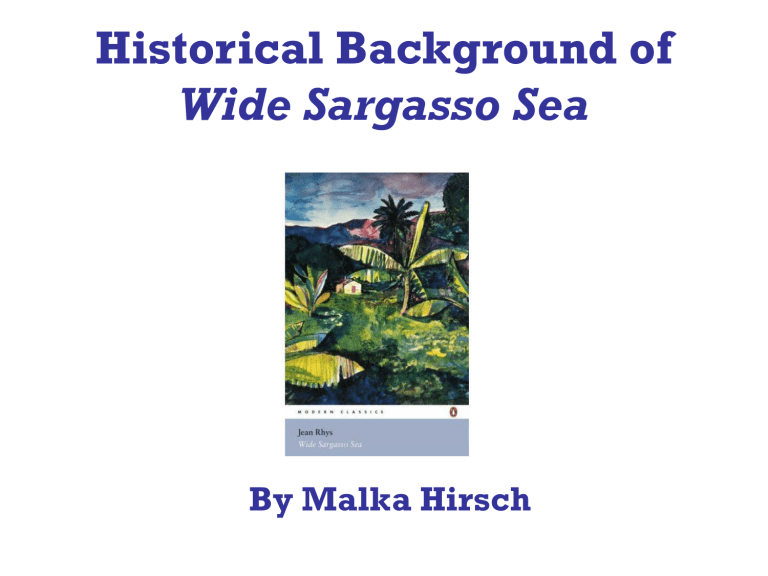
Historical Background of
Wide Sargasso Sea
By Malka Hirsch
Authors background
Wide Sargasso Sea was
Written in 1966 by a
Dominica born author
Jean Rhys.
She was born in 1894 and moved to England when she was 16 years old (1910).
Upon her arrival Jane
Eyre was one of the first novels she read.
Rhys’s life difficulties
Rhys never adjusted to the move from the west indies to
England.
Rhys always felt cold and removed and imagined that the character Bertha Mason from the novel Jane Eyre must have felt the same.
Rhys had chronic financial difficulties, she was marries three times and two of her husbands spent time in jail.
She was also a heavy drinker
Reasons for writing her Novel
The portrayal of Bertha in Jane
Eyre always disappointed her.
Since she came from the west indies and had difficulties adjusting in England the story had special significance to her.
Rhys wrote Wide Sargasso
Sea as a response to stereotypes informed by
Bronte’s nineteenth century
English culture and social status.
Rhys’s many difficulties led her to empathize with all kinds of human suffering regardless of the cause.
Rhys develops the complex character of Antoinette
Cosway, who Bronte describes as a mere lunatic in the novel
Jane Eyre .
Rhys’s empathy for
Bertha/Antoinette leads her to chose Bertha Mason’s ill fated marriage as a perfect subject to explore. Rhys takes the reader deep through her psyche as a way to better understand Bertha/Antoinette and the cause of her madness.
Colonialism in Jamaica
Rhys and her character Antoinette both grew up in the
British controlled colony of Jamaica.
The British Empire formally ruled Jamaica from 1670 as a result of the Treaty of Madrid.
Sugar became a luxury commodity ever since the development of large scale sugar plantations during the 1640’s.
There was a high demand for sugar after the British Empire seized control of the Island.
By 1750 Jamaica was the most important British colony in the west indies.
In 1834 the British parliament abolished all forms of slavery in their colonies.
The sudden loss of a large slave population was devastating for the
Jamaican economy.
Antoinette: Life in the West
Indies
Antoinette, the narrator for the first half of the story describes the difficulties of growing up in the 1830’s in Jamaica.
There was a strong feeling of isolation and loneliness that she experienced as a white
Creole child in a predominantly black West
Indies.
Antoinette’s character’s family were once rich and owned many slaves, but experienced a decline in their fortunes and status after the abolition of slavery.
One night locals surrounded her house and burnt it down leaving both Antoinette and her mother scarred.
Antoinette was so traumatized that she is forced to go to a convent to recover. On the other hand the extent of the trauma leads her mother to go insane.
Antoinette: Marriage to
Rochester
Antoinette’s step father arranges her marriage to
Rochester when she is 17 years old.
Rochester moves to
Jamaica to be with her and early on they are happily married.
When Rochester leans about her mother's insanity he distances himself from her and their marriage deteriorates.
As a result of a distanced marriage Antoinette begins to drink and attempts to use Voodoo to renew his interes.
Rochester tries to subdue his wife but none of his tactics work, so he decides to take her back to England and lock her in the attic.
Works Cited
• Lagretta, Lenker T. "Cyclopedia of Literary Characters."
MagillOnLiterature Plus . Salem Press, Feb. 1998. Web. 10 Apr.
2011.
• Meyers, Linda J. MagillOnLiterature Plus . Salem Press, Mar. 1995.
Web. 10 Apr. 2011.
• Mikolajek, Stanley J. "The History of Jamaica: From Colonialism and
Slavery to Emancipation and Independence, Page 8 of 8."
Associated Content from Yahoo! - Associatedcontent.com
. 4 Feb.
2011. Web. 11 Apr. 2011.
<http://www.associatedcontent.com/article/6261402/the_history_of_j amaica_from_colonialism_pg8.html?cat=37>.
• Stiffler, Tiffany E. "Masterplots." MagillOnLiterature Plus . Salem
Press, Nov. 2010. Web. 10 Apr. 2011.
• Ziskin, Alan. "Identities & Issues in Literature;." MagillOnLiterature
Plus . Salem Press, Sept. 1997. Web. 10 Apr. 2011.
